Abstract
Oxidized black copper ores are known for their difficulty in dissolving their components of interest through conventional methods. This is due to its non-crystalline and amorphous structure. Among these minerals, copper pitch and copper wad are of great interest because of their considerable concentrations of copper and manganese. Currently, these minerals are not incorporated into the extraction circuits or left untreated, whether in stock, leach pads, or waste. For the recovery of its main elements of interest (Cu and Mn), it is necessary to use reducing agents that dissolve the present MnO2, while allowing the recovery of Cu. In this research, the results for the dissolution of Mn and Cu from a black copper mineral are exposed, evaluating the reducing effect of NaCl for MnO2 through pre-treatment of agglomerate and curing, and subsequently leaching in standard condition with the use of a reducing agent (Fe2+). High concentrations of chloride in the agglomerate process and prolonged curing times would favor the reduction of MnO2, increasing the dissolution of Mn, while the addition of NaCl did not benefit Cu extractions. Under standard conditions, low Mn extractions were obtained, while in an acid-reducing medium, a significant dissolution of MnO2 was achieved, which supports the removal of Cu.
1. Introduction
The interactions that occur in mineral deposits through geological agents help the formation of new mineral species [1]. An example is the oxidation of pyrite, which when reacted with water produces sulfuric acid, favouring the mobility of metals like copper, which under particular conditions of potential and pH can be transported, precipitating downstream, forming deposits called “exotic” [2]. The principal copper minerals being in this type of deposit are chrysocolla-atacamite, copper-pitch, and copper-wad [3].
The “copper wad” and “copper pitch” are hydrated silicates of manganese and iron, rich in copper, which appear as brotoidal masses, compact or earthy. When it is alone and shows earthy habit, it is called wad; if it is associated with chrysocolla, it is called pitch or “black chrysocolla” [4]. Pincheira et al. [5] proposed the name of black copper silicate to designate both mineraloids, without crystalline structure. They have a similar composition and in greater quantity are elements such as Cu, Mn, Fe, Al, and Si, accompanied by traces of Ca, Na, K, Mg, S, P, Cl, Mo, Co, Ni, As, Zn, Pb, U, V.
Black copper ores are a resource that is generally not incorporated into the extraction circuits or left untreated, whether in stock, leach pads, or waste [6,7]. This is due to the difficulty of recovering elements of interest like Cu or Mn by conventional hydrometallurgical processes since the complex structure is non-crystalline or amorphous [8]. However, several studies have been carried out to extract these elements from marine nodules and other manganese minerals, which generates alternatives for processing by similar leaching systems.
Several studies have been carried out in recent years for the extraction of Mn from marine nodules in acidic media, testing diverse reducing agents such as oxalic acid [9], glucose [10], FeO [11], cane molasses [12], corn cob [13], biomass from residual tea [14], etc. Toro et al. [15,16] obtained promising results when employing FeSO4, formed from the reaction between tailings and H2SO4. Benavente et al. [7] conducted a study for the dissolution of Cu and Mn from black copper under oxidizing and reducing conditions. The authors indicated that at oxidizing conditions, better results are not obtained than in a standard state (without oxidizing agents or reducing agents), concluding that the addition of an oxidizing agent does not improve the dissolution rate of black copper. Otherwise, in a reducing condition, the decrease in redox potential favors the dissolution of manganese, increasing the extraction of Cu.
Wang and Zhou [17] investigated the recovery of cobalt from residues of zinc plants by a hydrometallurgical process, using ammonium peroxydisulfate ((NH4)2S2O8) for the precipitation of manganese as MnO2. The researchers noted that the chloride ion negatively affected manganese precipitation, which was attributed to the reduction of manganese oxide. The standard redox potentials are: Mn3O4/Mn2+ = 1.76 V and Cl2/Cl− = 1.39 V. Then, it was concluded that manganese oxide could be thermodynamically reduced to Mn2+ through chloride. Fuerstenau and Han [18] indicated that by working at 100 °C in the leaching of marine nodules, good extractions of copper, nickel, and cobalt could be obtained after a long period of residence, either with sulfuric acid or hydrochloric acid. Senanayake [19] compared the leaching of marine nodules in H2SO4 and HCl, in temperature ranges of 30–90 °C, with absence and presence of SO2, Na2SO3, NaCl, and CaCl2, concluding that at a higher temperature (90 °C) the HCl gives better results.
For the dissolution of manganese from black copper with the use of sulfuric acid and chloride, the following series of reactions is proposed:
(CuO × MnO2 × 7H2O)(s) + 3H2SO4(aq) + 2FeSO4(aq) + 2NaCl(s) = Fe2(SO4)3(aq) + MnCl2(aq) + CuSO4(aq) + Na2SO4(aq) + 10H2O(l)
MnO2(s) + 2Fe2+(aq) + 4H+(aq) = Mn2+(aq) + 2Fe3+(aq) + 2H2O(l) ΔG0 = −88.5 kJ
2FeSO4(aq) + 2H2SO4(aq) + MnO2(s) = Fe2(SO4)3(s) + 2H2O(l) + MnSO4(aq) ΔG0 = −200 kJ
4NaCl(s) + 2H2SO4(aq) + MnO2(s) = 2Na2SO4(aq) + MnCl2(aq) + Cl2(g) + 2H2O(l) ΔG0 = −73.5 kJ
On the other hand, pre-treatment processes that involve agglomeration and curing stages have shown positive results to improve mineral reaction rates [20,21]. In the study conducted by Bahamonde et al. [22], pre-treatment with sodium chloride and sulfuric acid was carried out to enhance copper extractions in a concentrate formed mainly by bornite and chalcopyrite. Different concentrations of sodium chloride (15, 30 and 60 kg/t) and cure time (15 and 30 d) were studied, where finally, a significant increase in Cu extractions was obtained. In a more recent study by Cerda et al. [21], pre-treatment experiments were carried out for a copper sulphide mineral (chalcopyrite), where sulfuric acid (20 kg/t) and sodium chloride were added at different concentrations (20, 50, and 90 kg/t). The authors concluded that the cure time is more important than the level of chloride in the agglomerate process.
Currently, the mining industry must generate a new approach that helps overcome the stagnation in its growth. Despite its surplus-generating role, large-scale mining faces significant challenges such as the deterioration of the ore grade, increased operational costs, and input costs must be adjusted to the demand for sustainable development [23]. In recent years, in Chile the treatment of other commodities has been incorporated into the extraction processes, for example, the recovery of Mo together with the Cu in flotation processes has been encouraged [24]. This helps to diversify the business and boost the export of additional products [6]. It is necessary to incorporate the minerals of black copper in the leaching processes, because of their considerable amounts of Mn (29%) which, when dissolved, favor the extraction of Cu, and would allow giving a high commercial value of these “residues”.
In this research, the outcomes for the dissolution of Mn and Cu from a black copper ore are exposed. The reducing effect of NaCl for MnO2 was evaluated by pre-treatment, adding this reagent in the agglomerate stage and then leaving it at rest. Subsequently, a leaching process was carried out under standard conditions and adding a reducing agent (Fe2+).
2. Experimental
2.1. Black Copper Simple
For the present study, a sample of black copper from a mining company in northern Chile was used. The sample was from a high-grade vein, with purity near to 100%. The ore was ground in a porcelain mortar to sizing between −173 and +147 µm. The chemical composition was determined by inductively coupled plasma atomic emission spectrometry (ICP-AES) (see Table 1). A QEMSCAN (Quantitative Evaluation of Minerals by SCANning) analysis was applied, which is a modified electronic scanning microscope, both in hardware and software. This performs the identification and automated quantification of ranges of elementary definitions that can be associated with inorganic solid phases (minerals, alloys, slags, etc.). The samples were mounted on briquettes and polished to determine the mineralogical composition. The identification, mapping of 2-D distribution, and quantification of inorganic phases were done by combining the emissions of retro-dispersed electrons (BSE), with a Zeiss EVO series, a Bruker AXS XFlash 4010 detector (Bruker, Billerica, MA, USA), and the iDiscover 5.3.2.501 software (FEI Company, Brisbane, Australia). The QEMSCAN analyses are based on the automated obtaining of EDS spectra (dispersed energy from X-rays), in hundreds of thousands or millions of collected analysis points, each in a time of milliseconds. The classification of mineralogical phases was done by classifying each EDS spectrum in a hierarchical and descending compositional list, known as the “SIP List”. The BSE image was used to discriminate between resin and graphite in the sample, to specify entries in the SIP list, and to establish thresholds for acceptance or rejection of particles. As a result, pixelated, 2-D and false color images of a specimen or a representative subsample of particles are obtained. Each pixel retains its elementary and BSE brightness information, which allows subsequent offline data processing. Through software, customized filters are generated that quantify the ore and gangue species, mineral release, associations between inorganic phases, classifying particles according to criteria of shape, size, texture, etc. Figure 1 shows the chemical species to black oxides using QEMSCAN.

Table 1.
Chemical composition of black oxide samples.
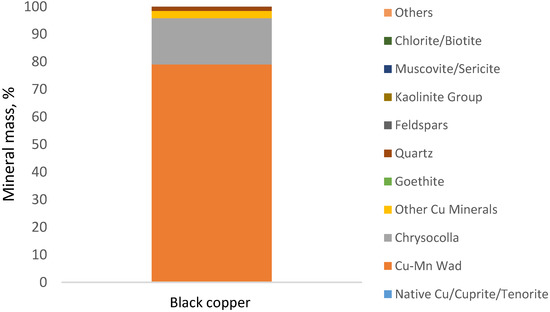
Figure 1.
Detailed modal mineralogy.
Table 2 shows the mineralogical composition of the black copper samples. Copper wad refers to a subgroup of copper composed of manganese and copper hydroxides, as well as also traces of other elements such as Co, Ca, Fe, Al, Si, and Mg.

Table 2.
The mineralogical composition of the black copper samples as determined by QEMSCAN.
2.2. Ferrous Ions
The ferrous ions used for this investigation (FeSO4 × 7H2O) were WINKLER brand, with a molecular weight of 278.01 g/mol. These were incorporated during the leaching process in stirred reactors, after the pretreatment process.
2.3. Pre-Treatment and Subsequent Leaching in reactors
For the pre-treatment, we worked with 10 g of ore, adding 20 kg of H2SO4/t (according to the level to be studied) and different concentrations of NaCl (See Table 1). The sample and reagents were homogenized and subsequently placed on a Petri dish, which was covered with plastic to avoid evaporation. The temperature during the resting time was controlled at 25 °C with the use of an air conditioner. Subsequently, leaching tests were carried out in a 100-mL glass reactor with a 0.01 S/L ratio. A total of 10 g of black copper ore and MnO2 (manganese nodules) at different concentrations were mixed and dispersed with a five-position magnetic stirrer (IKA ROS, CEP 13087-534, Campinas, Brazil) at a speed of 600 rpm. The temperature was controlled at 25 °C using an oil-heated circulator (Julabo) (Julabo, St. Louis, MO, USA). All the tests were duplicated, and the measurements (or analyses) were carried out on 5 mL undiluted samples using atomic absorption spectrometry with a coefficient of variation ≤5% and a relative error between 5 to 10%. Measurements of pH and oxidation-reduction potential (ORP) of leach solutions were made using a pH-ORP meter (HANNA HI-4222) (HANNA instruments, Woonsocket, RI, USA). The ORP solution was measured in a combination ORP electrode cell of a platinum working electrode and a saturated Ag/AgCl reference electrode.
2.4. Dissolution of Mn and Cu
In a previous research conducted by Wang and Zhou [17], it was discovered that after a long contact time, chloride could reduce MnO2. For this reason, it was resolved to assess this impact by agglomerate assays and subsequently a leaching process.
For the agglomerate tests, we worked by adding 20 kg of H2SO4/t and 10 kg of NaCl/t, with a curing time of 48 h. While the following operational parameters were used for leaching: Fe2+/MnO2 ratio of 1/1, particle size of −75 + 53 μm, agitation rate of 600 rpm, 1 mol/L sulfuric acid, and room temperature (25 °C).
2.5. Effect of NaCl Concentration and Cure Time
For the agglomerate and curing tests, we worked under the parameters presented in Table 3:

Table 3.
Variables studied in the pretreatment step.
For the leaching tests, the following operational parameters were worked: Fe2+/MnO2 ratio of 1/1, particle size of −75 + 53 μm, agitation rate of 600 rpm, 1 mol/L sulfuric acid, and room temperature (25 °C).
3. Results
3.1. Effect of Agglomerate with NaCl to Dissolve Mn
Figure 2 shows the dissolution of Mn from a sample of black copper under four conditions: (1) without the use of reducing agent or prior agglomerate (standard state), (2) with the use of reducing agent (Fe2+) without prior agglomerate, (3) without reducing agent, but with a previous agglomerate process (Standard condition + NaCl), (4) with previous agglomerate and use of reducing agent (Fe2+ + NaCl). It can be seen that without the use of a reducing agent, it is not possible to dissolve the Mn present in the black copper sample and, besides, a beneficial effect cannot be appreciated by adding chloride to the system. This is consistent with the results obtained by Benavente et al. [7], where Mn was not dissolved for a black copper ore under standard conditions. On the other hand, it can be seen that with the use of Fe2+ high solutions of Mn (over 50%) are obtained in short periods (20 min), a result very similar to that set forth by Pérez et al. [6] under similar conditions. When a previous agglomerate process is added by adding NaCl, a positive effect on the dissolution of Mn is generated. This allows confirming the statements made by Wang and Zhou [17], who indicate that the chloride being in contact with MnO2 for a long time can generate a reducing effect on the mineral, favoring its subsequent leaching.
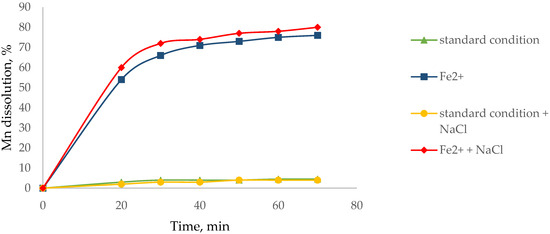
Figure 2.
Dissolution of Mn from a black copper ore.
3.2. Effect of Agglomerate with NaCl to Dissolve Cu
Figure 3 shows the dissolution of Cu from a sample of black copper under the same conditions previously set out in Figure 2. There was no beneficial effect on the dissolution of copper when performing a previous agglomerate process by adding NaCl, but promising outcomes were achieved when adding a reducing agent. In the study conducted by Benavente et al. [7], it was indicated that no favorable results are obtained by adding O2 for the dissolution of Cu from black copper ore. This situation was improved by working in a reducing condition, which favors the dissolution of MnO2 by means of a reducing agent in an acid medium [11,25,26,27], allowing subsequent increase in Cu extractions.
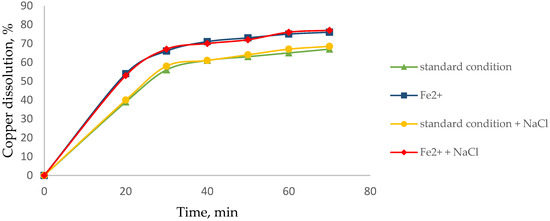
Figure 3.
Dissolution of Cu from a black copper ore. Effect of NaCl concentration and cure time.
3.3. Effect of NaCl Concentration and Cure Time
Figure 4 shows the effect of carrying out a pre-treatment process by adding NaCl, giving a rest time and subsequently leaching the material. Sodium chloride did not generate any increase in the dissolution of Cu from black copper. However, a positive effect on manganese dissolution was seen, as the concentration of NaCl in the pre-treatment increased. In general, better results were obtained for both elements as the curing time increased, which is consistent with previous researches for the dissolution of Cu minerals [20,21]. A beneficial effect is also observed in the reductive leaching of MnO2 over time, as the chloride concentration increased. The potential and pH values were in the range of −0.2 to 1.5 V and −0.5 to 0.4, for all the tests performed. These results are consistent according to the statement by Senanayake et al. [19], where it is indicated that the ranges of pH and potential suitable for a leaching of MnO2 reductive using Fe are from −2 to 0.1 and −0.4 to 1.4 [28]. In addition, when working in these ranges, Mn ions remain in solution, and do not precipitate through oxidation-reduction reactions [29].
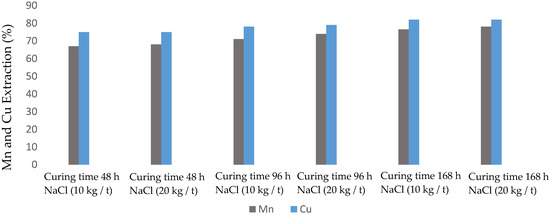
Figure 4.
Effect of NaCl concentration and cure time on the dissolution of Mn and Cu.
Figure 5 shows that the main compound in the residues is copper oxide that has not yet dissolved, this oxide is from black copper, chrysocolla, and other copper oxides (tenorite, cuprite, among others) that were present in the initial mineral. The presence of copper-chloride complexes within the system stands out, this is mainly due to the curing with NaCl and the formation of solid species such as CuCl. The other species are oxides of manganese, iron and aluminum and silicon species, the latter elements originating from the chrysocolla and are present in small quantities in the mineral residue.
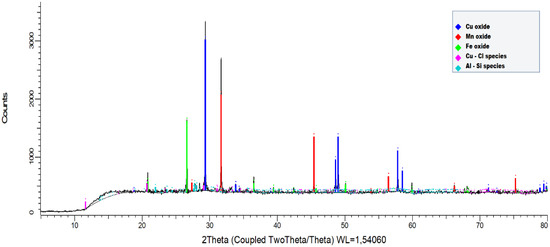
Figure 5.
X-ray diffractogram for solid residue (black copper ore) after being leached at 25 °C with NaCl and FeSO4 in a time of 70 min.
4. Conclusions
The present research displays outcomes where it is sought to dissolve Cu and Mn from black copper, with a pre-treatment of agglomerate incorporating NaCl, a cured time and subsequent acid-reducing leaching at room temperature (25 °C). The main findings are the following:
Under standard conditions, low Mn solutions were obtained, and pre-treatment with NaCl did not influence the solutions thereof.
When working in an acid-reducing medium, a more significant dissolution of MnO2 was achieved, which favors the extraction of Cu.
High concentrations of chloride in the agglomerate process and prolonged curing times would favor the reduction of MnO2, increasing the dissolution of Mn.
An increase in curing time favors Cu solutions while the addition of NaCl in the agglomerate process is irrelevant for its dissolution.
Author Contributions
D.T. and K.P. contributed in research and wrote paper, N.T. and R.I.J. contributed in project administration, E.T. and P.R. contributed resources, P.R. contributed in review and editing and E.S.-R. contributed in data curing. All authors have read and agreed to the published version of the manuscript.
Acknowledgments
The authors are grateful for the contribution of the Scientific Equipment Unit-MAINI of the Universidad Católica del Norte for facilitating the chemical analysis of the solutions. Pedro Robles thanks the Pontificia Universidad Católica de Valparaíso for the support provided. Also, we thanks Conicyt Fondecyt 11171036 and Centro CRHIAM Project Conicyt/Fondap/15130015.
Conflicts of Interest
The authors declare they have no conflict of interest.
References
- Cuadra, C.P.; Rojas, S.G. Oxide mineralization at the Radomiro Tomic porphyry copper deposit, Northern Chile. Econ. Geol. 2001, 96, 387–400. [Google Scholar]
- Pinget, M.; Dold, B.; Fontboté, L. Exotic mineralization at Chuquicamata, Chile: Focus on the copper wad enigma. In Proceedings of the 10th Swiss Geoscience Meeting, Bern, Switzerland, 16–17 November 2012; pp. 88–89. [Google Scholar]
- Kojima, S.; Astudillo, J.; Rojo, J.; Tristá, D.; Hayashi, K.I. Ore mineralogy, fluid inclusion, and stable isotopic characteristics of stratiform copper deposits in the coastal Cordillera of northern Chile. Miner. Depos. 2003, 38, 208–216. [Google Scholar] [CrossRef]
- Chavez, W.X., Jr. Supergene oxidation of copper deposits; zoning and distribution of copper oxide minerals. SEG Newsl. 2000, 41, 1–21. [Google Scholar]
- Pincheira, M.; Dagnini, A.; Kelm, U.; Helle, S. Copper pitch y copper wad: Contraste entre las fases presentes en las cabezas y en los ripios en pruebas de mina sur, Chuquicamata. In Proceedings of the X Congreso Geológico Chileno; 10° CONGRESO GEOLÓGICO CHILENO 2003, Concepción, Chile, 6–10 October 2003; p. 10. [Google Scholar]
- Pérez, K.; Toro, N.; Campos, E.; González, J.; Jeldres, R.I.; Nazer, A.; Rodriguez, M.H. Extraction of Mn from black copper using iron oxides from tailings and Fe2+ as reducing agents in acid medium. Metals (Basel) 2019, 9, 1112. [Google Scholar] [CrossRef]
- Benavente, O.; Hernández, M.C.; Melo, E.; Núñez, D.; Quezada, V.; Zepeda, Y. Copper dissolution from black copper ore under oxidizing and reducing conditions. Metals (Basel) 2019, 9, 799. [Google Scholar] [CrossRef]
- Helle, S.; Pincheira, M.; Jerez, O.; Kelm, U. Sequential extraction to predict the leaching potential of refractory black copper ores. In Proceedings of the XV Balkan Mineral Processing Congress, Sozopol, Bulgaria, 12–16 June 2013; pp. 109–111. [Google Scholar]
- Sahoo, R.N.; Naik, P.K.; Das, S.C. Leaching of manganese from low-grade manganese ore using oxalic acid as reductant in sulphuric acid solution. Hydrometallurgy 2001, 62, 157–163. [Google Scholar] [CrossRef]
- Furlani, G.; Pagnanelli, F.; Toro, L. Reductive acid leaching of manganese dioxide with glucose: Identification of oxidation derivatives of glucose. Hydrometallurgy 2006, 81, 234–240. [Google Scholar] [CrossRef]
- Bafghi, M.S.; Zakeri, A.; Ghasemi, Z.; Adeli, M. Reductive dissolution of manganese ore in sulfuric acid in the presence of iron metal. Hydrometallurgy 2008, 90, 207–212. [Google Scholar] [CrossRef]
- Su, H.; Wen, Y.; Wang, F.; Sun, Y.; Tong, Z. Reductive leaching of manganese from low-grade manganese ore in H2SO4 using cane molasses as reductant. Hydrometallurgy 2008, 93, 136–139. [Google Scholar] [CrossRef]
- Tian, X.; Wen, X.; Yang, C.; Liang, Y.; Pi, Z.; Wang, Y. Reductive leaching of manganese from low-grade manganese dioxide ores using corncob as reductant in sulfuric acid solution. Hydrometallurgy 2010, 100, 157–160. [Google Scholar] [CrossRef]
- Tang, Q.; Zhong, H.; Wang, S.; Li, J.Z.; Liu, G.Y. Reductive leaching of manganese oxide ores using waste tea as reductant in sulfuric acid solution. Trans. Nonferrous Met. Soc. China (Engl. Ed.) 2014, 24, 861–867. [Google Scholar] [CrossRef]
- Toro, N.; Saldaña, M.; Castillo, J.; Higuera, F.; Acosta, R. Leaching of manganese from marine nodules at room temperature with the use of sulfuric acid and the addition of tailings. Minerals 2019, 9, 289. [Google Scholar] [CrossRef]
- Toro, N.; Saldaña, M.; Gálvez, E.; Cánovas, M.; Trigueros, E.; Castillo, J.; Hernández, P.C. Optimization of parameters for the dissolution of Mn from manganese nodules with the use of tailings in an acid medium. Minerals 2019, 9, 387. [Google Scholar] [CrossRef]
- Wang, Y.; Zhou, C. Hydrometallurgical process for recovery of cobalt from zinc plant residue. Hydrometallurgy 2002, 63, 225–234. [Google Scholar] [CrossRef]
- Fuerstenau, D.W.; Han, K.N. Metallurgy and processing of marine manganese nodules. Miner. Process. Extr. Metall. Rev. 1983, 1, 1–83. [Google Scholar] [CrossRef]
- Senanayake, G. Acid leaching of metals from deep-sea manganese nodules—A critical review of fundamentals and applications. Miner. Eng. 2011, 24, 1379–1396. [Google Scholar] [CrossRef]
- Velásquez-yévenes, L.; Torres, D.; Toro, N. Hydrometallurgy Leaching of chalcopyrite ore agglomerated with high chloride concentration and high curing periods. Hydrometallurgy 2018, 181, 215–220. [Google Scholar] [CrossRef]
- Cerda, C.P.; Taboada, M.E.; Jamett, N.E.; Ghorbani, Y.; Hernández, P.C. Effect of pretreatment on leaching primary copper sulfide in acid-chloride media. Minerals 2018, 8, 1. [Google Scholar] [CrossRef]
- Bahamonde, F.; Gómez, M.; Navarro, P. Pre-treatment with sodium chloride and sulfuric acid of a bornitic concentrate and later leaching in chloride solution. In Proceedings of the Leaching and Bioleaching of Sulfide Concentrates and Minerals, Hydroprocess-ICMSE, Santiago, Chile, 22 June 2017. [Google Scholar]
- Toro, N.; Briceño, W.; Pérez, K.; Cánovas, M.; Trigueros, E.; Sepúlveda, R.; Hernández, P. Leaching of pure chalcocite in a chloride media using sea water and waste water. Metals (Basel) 2019, 9, 780. [Google Scholar] [CrossRef]
- Cruz, C.; Reyes, A.; Jeldres, R.I.; Cisternas, L.A.; Kraslawski, A. Using partial desalination treatment to improve the recovery of copper and molybdenum minerals in the Chilean mining industry. Ind. Eng. Chem. Res. 2019, 58, 8915–8922. [Google Scholar] [CrossRef]
- Zakeri, A.; Bafghi, M.; Shahriari, S. Dissolution kinetics of manganese dioxide ore in sulfuric acid in the presence of ferrous ion. Iran. J. Mater. Sci. Eng. 2007, 4, 22–27. [Google Scholar]
- Toro, N.; Herrera, N.; Castillo, J.; Torres, C.; Sepúlveda, R. Initial Investigation into the leaching of manganese from nodules at room temperature with the use of sulfuric acid and the addition of foundry slag—Part I. Minerals 2018, 8, 565. [Google Scholar] [CrossRef]
- Saldaña, M.; Toro, N.; Castillo, J.; Hernández, P.; Trigueros, E.; Navarra, A. Development of an analytical model for the extraction of manganese from marine nodules. Metals (Basel) 2019, 9, 903. [Google Scholar] [CrossRef]
- Torres, D.; Ayala, L.; Saldaña, M.; Cánovas, M.; Jeldres, R.I.; Nieto, S.; Castillo, J.; Robles, P.; Toro, N. Leaching manganese nodules in an acid medium and room temperature comparing the use of different Fe reducing agents. Metals (Basel) 2019, 9, 1316. [Google Scholar] [CrossRef]
- Komnitsas, K.; Bazdanis, G.; Bartzas, G.; Sahinkaya, E.; Zaharaki, D. Removal of heavy metals from leachates using organic/inorganic permeable reactive barriers. Desalin. Water Treat. 2013, 51, 3052–3059. [Google Scholar] [CrossRef]
© 2020 by the authors. Licensee MDPI, Basel, Switzerland. This article is an open access article distributed under the terms and conditions of the Creative Commons Attribution (CC BY) license (http://creativecommons.org/licenses/by/4.0/).